

The River Thames is rich in a variety of wildlife. So please click the icon of the section that interests you.
Landscape |
Flora |
||
Insects, Crustaceans and |
Fish |
||
Birds |
Mammals |
The River Thames is a lowland river throughout most of its course and as a result its landscape is fairly gentle with little striking changes in scenery or gradient. The exception of course, in the Goring Gap where the River has cut its way through the chalk hills dividing the Chilterns from the Berkshire Downs and where the rich grasslands and Beech woods are of spectacular appearance.
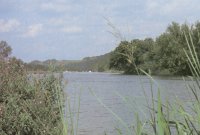 |
The Thames above Pangbourne |
The characteristic habitats along the rural Thames are woodlands, water meadows and pastures. Meadows, cut for hay, and pastures, grazed by livestock, have been the traditional type of farming in the Thames Valley for centuries and contain many native species of grasses and herbs. However, drainage, ploughing, herbicides, fertilizers and agricultural grass seed mixtures have converted many of these areas into high yielding grasslands and arable crop fields. Despite this however, a few ancient water meadows and pastures still exist, particularly between the source and Oxford, and are in fact some of Britain's richest grasslands in terms of number of species growing on them.Of particular importance are the herb rich meadows in the floodplain at Oxford such as Iffley Meadows and Pixey & Yarnton Meads. Also at Oxford, is Port Meadow where the last remaining site for the rare creeping marshwort plant can be found.
There are some 146 Sites of Special Scientific Interest (SSSI) within 5 kilometres of its banks. It also has two National Nature Reserves, North Meadow at Cricklade and Chimney Meadow in Oxfordshire.
Through London, the Tidal Thames provides a wildlife corridor, where the range of salinity, temperature, tidal flow and sediment type supports a wide variety of habitat conditions. But no two reaches are ever quite the same in appearance. Between Teddington and Richmond the River has a natural aspect with grassy banks and trees growing close to the River's edge. Small islands, or aits, break the River's flow and provide shelter for water birds and insects.
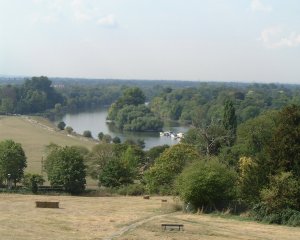 |
The Thames from Richmond Hill |
Below Richmond, the River is flanked by Syon Park on the north bank and by Kew Gardens to the south but below Kew Bridge the River becomes much busier, the banks become more artificial, buildings and roads intrude into the background and the foreshore, the areas between high and low water, which is predominantly shingle in the upper reaches, becomes progressively muddier in the lower reaches below Greenwich. However, this foreshore, provides a rich habitat for invertebrates, fish and birds and allows them to move up and downstream to fulfil their life cycles.
Downstream of London, many parts of the riverside are taken up with industrial complexes and landfill sites, such as Rainham Marsh which is perhaps one of the best areas for birds on the Tidal Thames. Further downstream are the salt marshes and other wide open spaces again rich in wildlife.
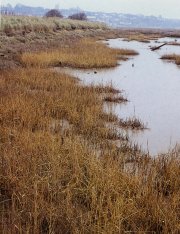 |
Saltmarshes of the Thames Estuary |
Many of the plants associated with the River Thames are those that can be seen along any lowland water but two plants are very important and are almsost unique to the Thames. The first is the Snake's-head Fritillary which can be seen along the water meadows of the upper Thames and in particular at North Meadow, Cricklade and Magdalen Meadow in Oxford. The second plant is the rare Summer Snowflake known as the Loddon Lily which takes its name from the River Loddon - a tributary of the River Thames joining below Shiplake Lock. It grows in the swampy soil beneath Willows and Alder, in damp woodland and in the wet meadows. It flowers in April and May and reaches a height of about 60cm.
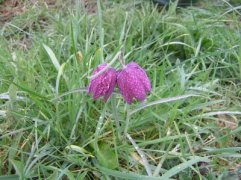 |
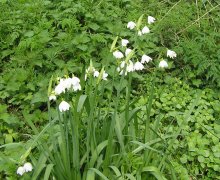 |
Snake's-Head Fritillary |
Loddon Lily |
In Britain Orchids are rare but in the wet grasslands boardering the Thames, the early Marsh Orchid is a fairly common species. Rare species however, are not the only attraction: many common species contribute to the beauty of the Thames. Fields of golden coloured Dandelions or Buttercups are among the dominant flowers providing fields of colour in June. Among these dominant species can be seen patches of other common flowers such as the brilliant pink Ragged Robin, Meadowsweet, Purple-red Great Burnet and Quaking Grass.
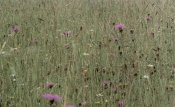 |
Water Meadow in Flower |
Willows and Alders are typical bankside trees but in the many woodlands that line the River, Beech is a dominant species.
In the water, plant life can be sparse due to dredging and the disurbance caused by wash from boats but Arrowhead, with its arrow-shaped green leaves and pinkish white flowers, grow in clusters along the riverbank particularly in the quieter areas. Also close to the banks, but in deeper water, can be seen the familiar Reed Mace with its cylindrical brown spears and sword like leaves. Incorrectly, these are often referred to as bulrushes, but they are a completly different plant.
 |
Arrowhead |
East of London, many of the wastelands are providing refuge for wildlife and plants such as the Rosebay Willowherb. Further downstream, Common Sea Lavender can be found in abundance on the Thames saltmarshes.
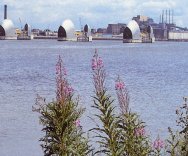 |
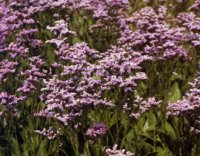 |
Rosebay Willowherb |
Sea Lavender |
INSECTS, CRUSTACEANS and OTHER INVERTEBRATES
There are numerous small animals known as invertebrates (animals without backbones) now living in or along the Thames. Many go un-noticed, living in the depths of the River, hiding under rocks, crawling along the foreshore or drifting on the surface of the water but without them, the fish population would be without food.
Most of these animals prefer either the freshwater or fully marine zones of the River but there are some that will tolerate the brackish water zone (a mixture of fresh and saline water). These include the Brown and Opossum Shrimp, Prawns, Oligochaete Worms, Ragworms, Shore Crabs and Chinese Mitten Crabs.
The Chinese Mitten Crab arrived in Europe, probably in the ballast water of ships from China, about 100 years ago but it did not reach the River Thames until 1935 when a single specimen was found at the Lots Road power station in Chelsea. However, in the last twenty years or so, population levels have escalated and it has now establised a considerable breeding population in the upper tidal section of the Thames. Not only is this causing extensive and severe erosion as it burrows into the mud of the river bank causing the collapse of banks, it is threatening many native freshwater fauna and flora including the eggs of fish that are laid on the river bottom. This species of crab spends most of its life in freshwater, only migrating downstream in late summer to breed. Unfortunately it has 'spread its wings' and is now established on the non-tidal Thames as far upstream as Staines and no doubt it will spread further.
 |
 |
 |
 |
Brown Shrimp |
Chinese Mitten Crab |
Shore Crab |
Ragworm |
In the freshwater Thames, during May and June, Alderflies, Mayflies (with their long triple tails) and Caddisflies (with their big moth like wings) are frequently seen along the River banks. The all spend their larval stages underwater when they are prey for many fish.
 |
Mayfly Nymph |
Dragonflies have a similar life history, but are themselves preditors both in the water as larvae and when flying. They eat flies, gnats and mosquitoes.
 |
 |
Dragonfly |
Damselfly |
Damselflies are much smaller and delicate with a hesitant, hovering flight, frequently alighting on plants. In June in the upper reaches, Damselfly nymphs crawl up the sedges and emerge as brilliant blue adults if they are male, or a slightly duller colour if they are female. Damselflies are not territorial like Dragonflies and therefore seem more common along the Riverbank.
In still pools out of the currents, Whirligig beetles, Waterboatmen and Pond Skaters can be seen running on the waters surface.
 |
Pond Skater |
Other invertebrates found in the freshwater Thames, particularly in the tidal section, include Water Hog-louse, Leeches, River Limpets, Snails and Shrimps.
 |
 |
 |
Water Hog-louse |
River Limpet |
Snail |
In the Marine Zone (saline waters), a number of invertebate animals can be found including several species of Crab (Swimming, Hermit and Spider), Edible Mussels, Sea Gooseberries (which look like small jellyfish), Cockles, Starfish and Whiteweed which looks like a plant but is in fact a colony of small animals related to the jellyfish.
 |
 |
 |
 |
Hermit Crab |
Edible Mussel |
Cockles |
Starfish |
 |
Whiteweed |
The River Thames is now home to some 120 fish species, including two rarities: the Twaite Shad (a type of migrating Herring) and Sea Lamprey, both of which are spawning in the tidal Thames.
In the non-tidal Thames, Roach, Chub, Perch, Pike and Bream can all be found along the whole of the River.
Roach, one of the most common species, are usually found around reed mace and where the water flows over a clean gravel bottom. Chub like cover, such as overhanging trees and bushes or in fact anything under which they can hide whilst Bream also favour gravelly runs and reed mace and are often found in weir pools. Perch is a strikingly barred fish that grows to about 45 cm. Pike are the most voracious fish-eating carnivore among all British freshwater species and can reach a weight of up to 20kg.
 |
 |
 |
 |
Roach |
Chub |
Perch |
Pike |
All of these species, along with Dace, are dominant in the Upper Thames (from the source to Eynsham). Dace are one of the most elegant of British coarse fish. They are very lively and dart around together. Barbel, a bottom dwelling fish, is one of the rarest native fish and can also be found in the faster flowing stretches of this part of the River. They frequent weir pools and are often seen where the current runs along the riverbank. Above Lechlade, Brown Trout are abundant where the River is narrower and faster flowing. They also favour the limestone and chalk tributaries of the river and the weir pools.
 |
 |
Dace |
Barbel |
In the Middle Thames (from Eynsham to Hurley), the dominant species are Bleak, Roach, Perch, Chub and Bream. Carp and Barbel are also found but only sporadically.
Carp is a large, long lived powerful fish. It is essentially a bottom feeder but can often be seen basking on the surface in the summer months.
 |
Carp |
In the Lower Thames (from Hurley to Teddington), Roach, Perch and Bream are the dominant species. Gudgeon, a small bottom living fish, and Dace can also be found but Dace is on the decline.
In a few places along the River, Tench, which is also a bottom dweller which can live in mud at the bottom of dried-up channels, may also be found.
In the upper reaches of the tidal Thames, between Teddington and Battersea ( where it is still freshwater despite the River being tidal up as far as Teddington), there are some 20 species of freshwater fish, including those found on the non-tidal River, but Roach and Dace are dominant.
In addition, 14 species of euryhaline fish (fish that can tolerate both salt and fresh water) including Smelt, Bass, Flounder, Trout, Twaite Shad and Allis Shad, and 86 species of marine fish have been recorded in the tidal Thames. These marine fish include Sprat, various species of Goby, Herring, Mullet, Plaice, Pouting, Eels and Sole
 |
 |
 |
Smelt |
Sand Goby |
Thin-lipped Mullet |
The Thames Estuary is an important nursery ground for a wide range of species including Flounder, Plaice and Dab. It is also the largest spawning ground for Sole in England and Wales. After 2 or 3 years, having reached a length of about 25cm, the Sole migrate out of the Estuary into the commercial fishing grounds of the southern North Sea.
The Estuary has also become a major nursery for Bass, with large numbers of fry moving into the Estuary in the summer months.
There is also a considerable seasonal migration of fish and their fry in the Tidal Thames. In March, Dace (the commonest freshwater fish in the Tidal Thames) and Smelt (a cousin of the Salmon) spawn around Wandsworth and their fry then migrate up the River to Teddington. In April and May, young eels (Elvers) ascend the River while in May and June it is young Flounders, about the size of a 5p piece, that are on the move. At about the age of three, the adult Flounders return to the sea to spawn. Common Goby fry move in June and it is then the turn of Bass fry in June, July and August. Thin Lipped Grey Mullet fry wait until October before they migrate upstream as far as Chiswick.
Nearly all of these migrating species move in dense shoals right up as far as Teddington and, apart from Dace, they all move down to the Estuary again during the winter months.
Small fry, even as small as 8mm long, are capable of moving up the estuary in a matter of days although they are unable to swim against the stronger currents. They enlist the help of the tide: they float up on the Incoming (flood) tide and then seek shelter in the margins of the channel during the outgoing (ebb) tide.
In 1974 salmon returned to the Thames - the first for 150 years!
 |
Salmon |
Salmon spawn in the upper freshwater tributaries producing young salmon, first called alevins and then parr. After 2 years they become silvery smolt which then migrate to the feeding grounds at sea. On reaching the sea, the Salmon grow rapidly and after one to three years they make their return journey to their home river as grilse to spawn and continue the cycle.
In 1979 the Thames Salmon Re-habilitation Scheme was launched in conjunction with the Thames Salmon Trust with the long term aim of restoring a self sustaining Salmon population in the River Thames. The Scheme involves fish rearing and stocking, the construction of Salmon ladders in the weirs upstream in the non-tidal Thames and a programme of evaluation. The last Salmon ladder to be built on the Thames was opened at Boulters Weir on 19 May 2000 by the Duke of Wellington. This completed the current programme and all the weirs from Teddington to Mapledurham now have ladders installed.
The Scheme has been successful with a sustained regular run of Salmon since 1982 with a record return of 338 Salmon in 1993. This is despite the fact that the migratory period for the returning Salmon is April to November, with the key period being July and August, which coincides with the period of reduced environmental quality on the tidal Thames due to reduced river flows and increased water temperatures. Unfortunately, since 1993 the numbers of returning Salmon have declined but there are still around 50 a year returning.
Finally on fish, recent research, commissioned by the Environment Agency, has found that Trout can swim through the water at 2.1 metres a second, about 4.7 miles per hour. Other coarse fish such as Roach, Dace and Chub are not far behind at 1.8 metres a second. Apparently, as natural hunters, Trout have developed strong muscles compared with Roach which tend to dawdle around the River bed and only swim fast over short distances when escaping from predators when they use maximum speed over a few seconds. After that they are exhausted! Swimming abilities also reflect habitat. As mentioned above, Trout tend to inhabit the faster flowing upper reaches of the River whereas Roach tend to live in the more sluggish waters.
 |
Seahorse |
Colonies of rare seahorses (Hippocampus hippocampus) are thriving in the shipping lanes off Dagenham, Tilbury and Southend.The tiny animals, which are protected by law, have been discovered by experts from the Zoological Society of London.They believe that the discovery demonstrates that the Thames is becoming a sustainable biodiverse habitat for aquatic life.
To go to Birds and Mammals Click Here
To return to The River Thames page Click Here
Copyright © The Harts